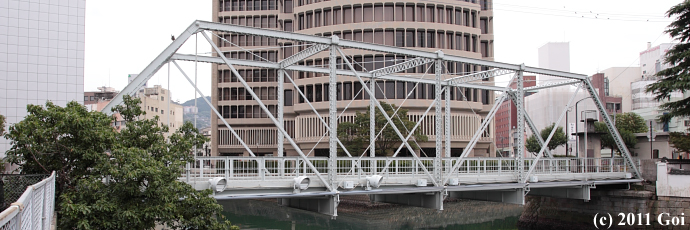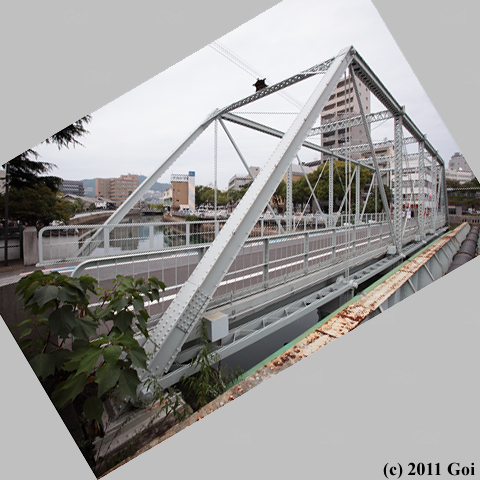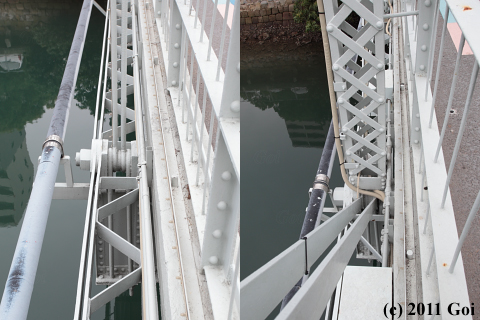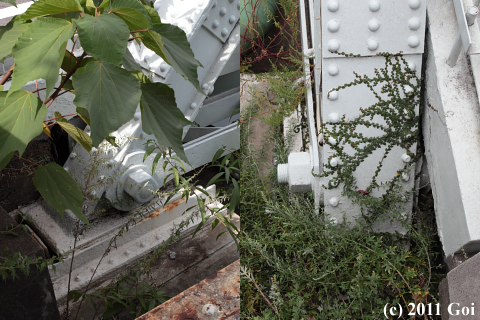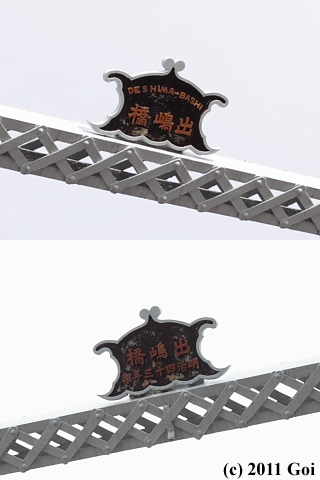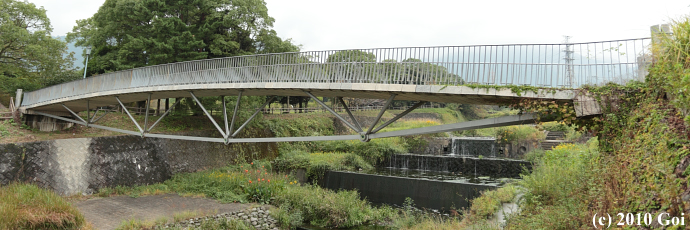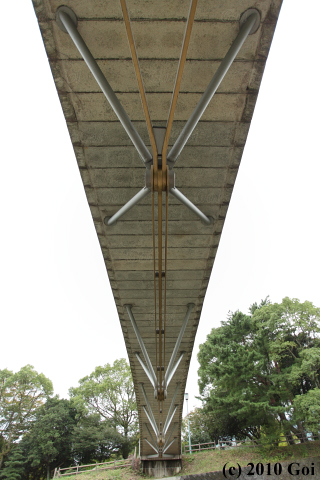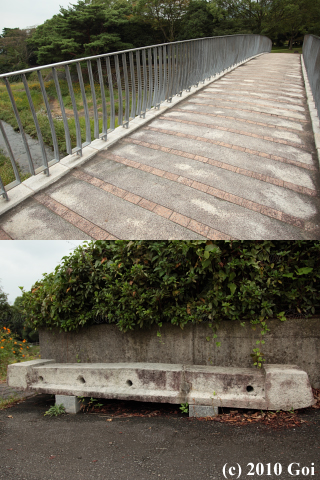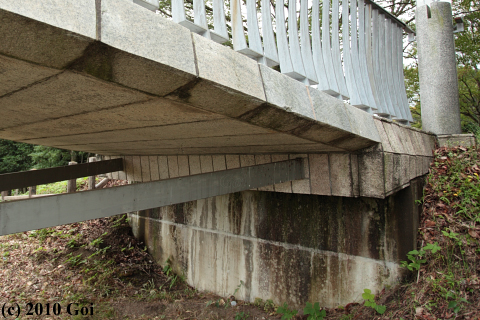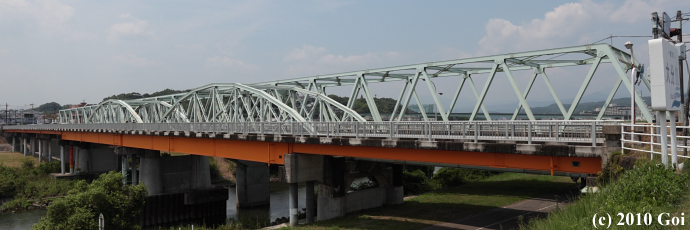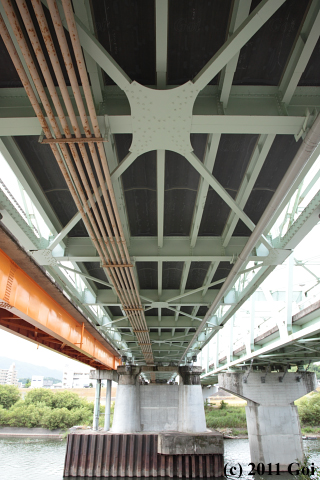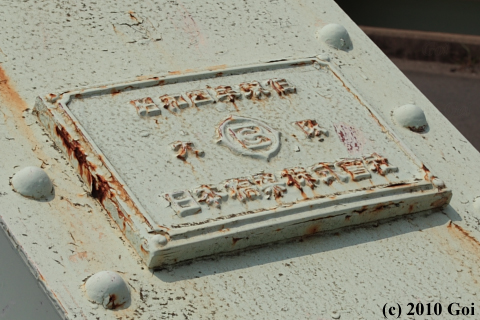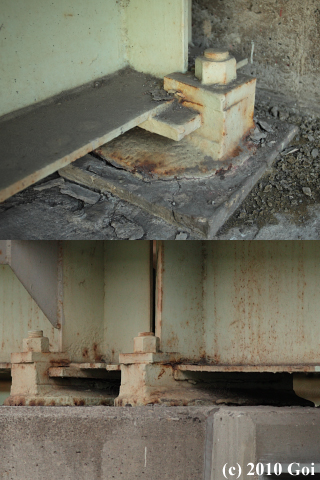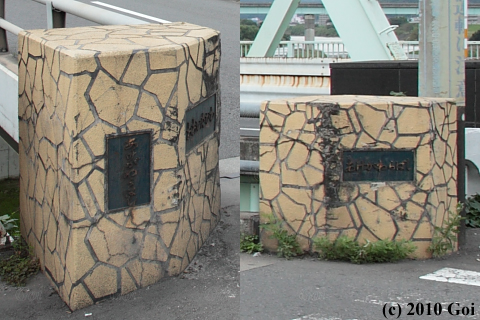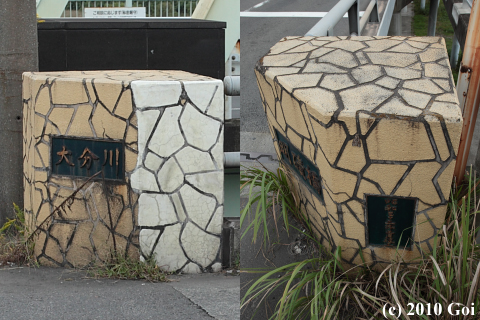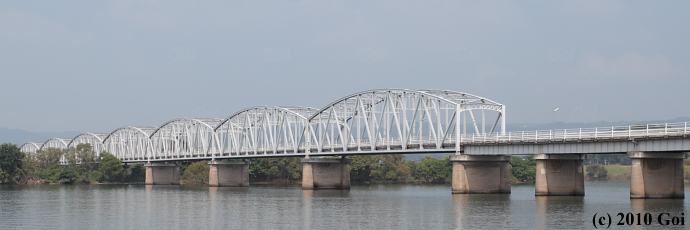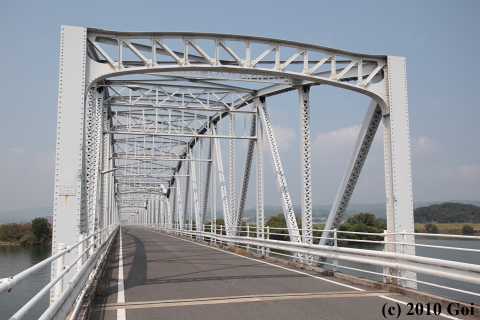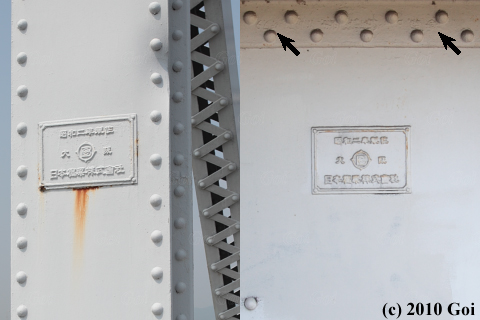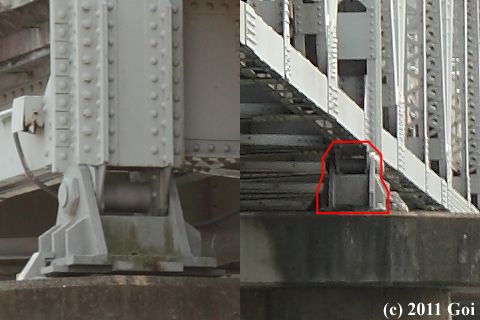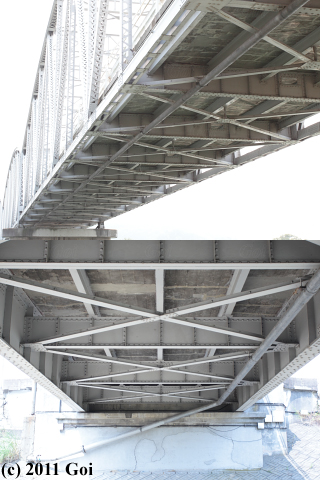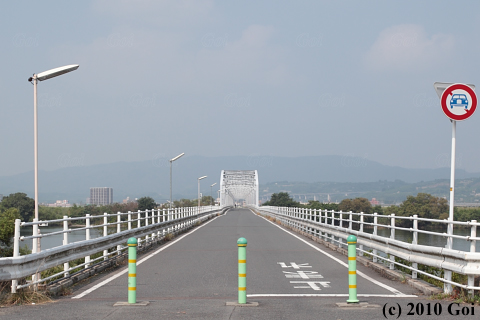出島 (でじま) 橋 :
Dejima Bridge
中島川に、出島橋が架かっていました (32.74352, 129.87413) (2010年 秋)。
Dejima Bridge spanned the Nakajima River (32.74352, 129.87413) (
Autumn, 2010).
出島橋は1径間からなり、鋼製の下路式直弦プラット・トラス橋が架けられていました。このトラス橋はピン結合で、下弦材はアイバーでした。アイバーは1格間の片側あたり4枚が使われ、内側の2枚は互いに結合されていました。
この橋は、当初は新川口橋として明治23年 (1890) に同じ中島川の河口に架けられ、その後、出島橋として明治43年 (1910) に現在の場所へ移設されたようです。
このトラス橋の材料はアメリカから輸入されたようです。
Dejima Bridge is composed of one span; a Pratt truss bridge with straight chords which is made of steel of through types, was spanned. The truss bridge was connected by pins, and lower chord members were eyebars. The eyebars were used four bars per the one side of one panel; the two eyebars of the inside were connected to each other.
It seems that, at first, the bridge as Shin-kawaguchi Bridge had been spanned at the mouth of the same Nakajima River in 1890; afterwards, the bridge as Dejima Bridge has been reset at the present place in 1910.
It seems that the materials of the truss bridge were imported from the United States of America.
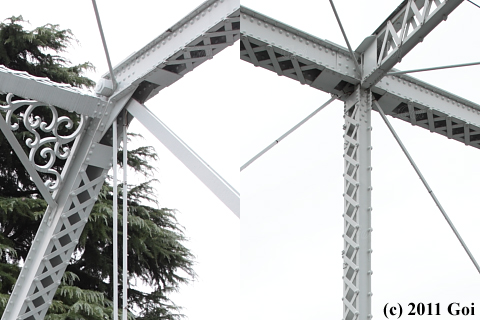
写真の左側が上弦材の端部で、右側が上弦材の中央部です。腹材と共に、横梁もピンで結合されているようです。
The left side of the photograph is one end of one upper chord member; the right side is the center of one upper chord member. Also the upper beams, with the web members, are seemingly connected by pins.
写真の左側が棒製の垂直材の下部で、右側がダブル・レーシングで組まれた垂直材の下部です。垂直材は、ピンを介して、横桁と結合されているようです。
The left side of the photograph is the lower end of one vertical post which was made of rods; the right side is the lower end of one vertical post which was built with double lacings. The vertical posts were seemingly connected to floor beams through pins.
床版の裏側です。縦桁は2本のようです。
This is the back of the slab. There are seemingly two stringers.
写真の左側が可動支承で、右側が固定支承のようです。
The left side of the photograph is seemingly an expansion bearing; the right side is seemingly a fixed bearing.
写真の上側が南側の橋門構にある銘板で、下側が北側の橋門構にある銘板です。
文字が、出「嶋」や DE「SHI」MA になっています。
The upper side of the photograph is the name plate on the portal bracing of the south side; the lower side is the name plate on the portal bracing of the north side.
Characters are 出 "嶋", and DE "SHI" MA.
橋門構の端部には、装飾が施されたものがありました。橋門構と比べて華奢なようなので、たぶん橋門構を剛にするためのものではないのでしょう。
There were things which were decorated at the ends of the portal bracings. Because those things are seemingly delicate in comparison with portal bracings, probably, those things are not things which exist in order to strengthen portal bracings.
イナコスの橋 :
Inachus Bridge
境川に、イナコスの橋が架かっていました (33.29253, 131.47448) (2010年 秋)。
Inachus Bridge spanned the Sakai River (33.29253, 131.47448) (
Autumn, 2010).
イナコスの橋は、ストランドによってアーチ・リブにプレストレスが加えられた、アーチ橋のようです。また、アーチ・リブの両端部が部材で結合されているようなので、タイド・アーチ橋の一種と思われます。
イナコスの橋はアーチ・リブが床版を兼ねた上路式です。上路式のタイド・アーチ橋はまれかもしれません。
It seems that Inachus Bridge is an arch bridge which the arch rib has been added
prestress by strands. And because it seems that both ends of the arch rib have been connected by members, the bridge is seemingly a kind of tied-arch bridges.
Inachus Bridge is deck types which the arch rib combined with the slab. Tied-arch bridges of deck types may be rare.
引張応力を負担するタイ材は鋼製のようでした。
The tie members which load tensile stress were seemingly made of steel.
床版を兼ねた圧縮応力を負担するアーチ・リブは、石でできていました。花崗岩のようです。
補修されたような床版の部材が、橋のたもとにありました。ストランドが通るようである穴がありました。(穴の一つは塞がれているようです。)
The arch rib which load compressive stress and combined with the slab was made of stones. It seems that those are granite.
There was one part of the slab which was seemingly repaired at one end of the bridge. There were holes which strands go seemingly through. (One of the holes had been seemingly closed.)
橋台には、アーチ・リブとタイの端部が一体化されて設置されていました。
At the abutments, the ends of the arch rib and tie are unified and have been put on.
写真の上側が北側の親柱で、下側が南側の親柱です。橋名等の表示はないようでした。
橋のたもとにある竣工記念碑によると、橋長は35.74mで、1994年 (平成6年) 3月までには竣工されたようです。
The upper side of the photograph is the newels of the north side; the lower side is the newels of the south side. There was not seemingly the sign of the bridge name etc.
From the completion monument at one end of the bridge; it seems that the length of the bridge is 35.74m, and the bridge has been completed by March, 1994.
明磧 (あけがわら) 橋 (旧橋) :
Akegawara Bridge (Old Bridge)
大分川に、明磧橋が架かっていました (33.20479, 131.58591) (2010年 夏・秋)。
ボーストリング・トラス橋が架けられた橋が明磧橋の旧橋で、直弦ワーレン・トラス橋が架けられた橋が明磧橋の新橋です。
手前のオレンジ色の人道橋は明磧橋側道橋で、昭和47年 (1972年) 3月に架けられたようです。
Akegawara Bridge spanned the Oita River (33.20479, 131.58591) (
Summer & Autumn, 2010).
The bridge which was spanned bowstring truss bridges is the old bridge of Akegawara Bridge; the bridge which was spanned Warren truss bridges with straight chords is the new bridge of Akegawara Bridge.
The orange footbridge of this side is Akegawara Sokudōkyō; it seems that it has been spanned in March, 1972.

現在の旧橋は7径間からなり、鋼製の下路式垂直材付きダブル・ワーレン・ボーストリング・トラス橋が2径間で、上路式ガーダー橋が5径間で架けられています。ガーダー橋は合成桁のようです。
当初は、旧橋は昭和4年に3径間からなる三等橋として、ボーストリング・トラス橋が2径間で、コンクリート製のガーダー橋が1径間で架けられていたようです。ボーストリング・トラス橋は、現在の旧橋へ再利用されたようです。
The present old bridge is composed of seven spans; double Warren bowstring truss with vertical posts bridges which are made of steel of through types were spanned at two spans; girder bridges of deck types were spanned at five spans. It seems that the girder bridges are composite girders.
It seems that, at first, the old bridge was composed of three spans as third class bridges; bowstring truss bridges had been spanned at two spans; a girder bridge which is made of concrete of deck types, had been spanned at one span. It seems that the bowstring truss bridges were reused to the present old bridge.
剛構造の橋門構は、上弦材の1格間にかけて設置されていました。8格間のうちで、横梁は1本だけでした。
Portal bracings with rigid construction were put on to one panel of upper chord members. In eight panels, upper beams existed only one.
トラス橋の床版の裏側と、橋脚です。
This is the back of the slab of one truss bridge, and one pier.
トラス橋の支承です。
写真の左側が固定支承で、右側が可動支承です。可動支承はローラー支承のようです。
These are the bearings of the truss bridges.
The left side of the photograph is a fixed bearing; the right side is an expansion bearing. The expansion bearings seemingly are roller bearings.
トラス橋の銘板です。トラス橋は、昭和4年 (1929年) に日本橋梁により製作されたようです。
This is the maker's plate on one truss bridge. It seems that the truss bridges were made by Japan Bridge in 1929.
トラス橋の上弦材には、官営八幡製鉄所のマークと、「BS 12 x 3 1/2 SEITETSUSHO YAWATA ヤワタ」の文字の陽刻がありました。「BS」は "British Standards" の略称で "英国規格" を表し、数字はインチでのサイズを表しているようです。(写真の下側は、コントラストなどが強められています。)
There were reliefs which are the mark of The State-owned Yawata Steel Works, and the characters of "BS 12 x 3 1/2 SEITETSUSHO YAWATA ヤワタ" on the upper chord members of the truss bridges. It seems that "BS" is the abbreviation of "British Standards", and the numbers express the size in inch. (The lower side of the photograph is intensified contrast etc.)
合成ガーダー橋の床版の裏側と、橋台です。
床版の裏側には、リベット状のものが並んでいました。ジベルかもしれません。
This is the back of the slab of one composite girder bridge, and one abutment.
Some kind of rivet were arranged at the backs of the slabs. Those may be shear connectors.
ガーダー橋の支承です。
写真の上側が固定支承で、下側の右側が可動支承のようです。線支承かもしれません。
These are the bearings of the girder bridges.
The upper side of the photograph is seemingly a fixed bearing; the right side of the lower side is seemingly an expansion bearing. The bearings may be line bearings.
ガーダー橋の銘板です。ガーダー橋は、瀧上工業により製作されたのかもしれません。
現在の旧橋は、二等橋として建造されたようです。
This is the maker's plate on one girder bridge. The girder bridges were possibly made by The Takigami Steel Construction.
It seems that the present old bridge has been constructed as second class.
旧橋の北側の親柱です。傷がついていました。
These are the newels of the north side of the old bridge. There were scratches on the newels.
旧橋の南側の親柱です。片方の親柱は補修されたようです。
親柱のプレートによると、現在の旧橋は昭和33年 (1958年) 3月に竣工されたようです。
These are the newels of the south side of the old bridge. The newel of one side was seemingly repaired.
According to a plate of one newel, it seems that the present old bridge has been completed in March, 1958.
霞 (かすみ) 橋 :
Kasumi Bridge
高梁川に、霞橋が架かっていました (34.56032, 133.70021) (2010年 夏)。
霞橋は20径間からなり、鋼製の下路式曲弦垂直材付きワーレン・トラス橋が7径間で、鋼製の上路式プレート・ガーダー橋が13径間で架けられていました。
Kasumi Bridge spanned the Takahashi River (34.56032, 133.70021) (
Summer, 2010).
Kasumi Bridge is composed of twenty spans; Warren truss with vertical posts bridges which are made of steel with arched chords of through types were spanned at seven spans; plate girder bridges which are made of steel of deck types, were spanned at thirteen spans.
トラス橋には、細い鋼材で造られた対傾構が、2格間毎に設置されていました。
Sway bracings which are made of thin steel were put on the truss bridges every two panels.
ガーダー橋は、トラス橋を挟んで、左岸側の11径間と右岸側の2径間にかけられていました。
The girder bridges on both sides of the truss bridges, at the eleven spans of the left bank side, and at the two spans of the right bank side, were spanned.
霞橋の上部構造は昭和2年 (1927年) に日本橋梁により製作され、橋は昭和3年 (1928年) に開通したようです。
写真の左側はトラス橋の銘板で、右側はガーダー橋の銘板です。
写真によると、ガーダー橋の銘板の上側の鋼材には、陽刻らしきものがあります。右側の矢印のは官営八幡製鉄所のマークのようで、左側の矢印のは「ヤワタ」(上下逆) の文字のようです。
It seems that the superstructures of Kasumi Bridge were made by Japan Bridge in 1927; the bridge was opened in 1928.
The left side of the photograph is the maker's plate on one truss bridge; the right side is the maker's plate on one girder bridge.
From the photograph, there are seemingly reliefs above the maker's plate on the girder bridge. The thing of the arrow of right side is seemingly the mark of The State-owned Yawata Steel Works, the things of the arrow of left side are seemingly the characters of "ヤワタ" (Yawata; upside-down).
トラス橋の支承です。
写真の左側が可動支承で、右側が固定支承です。
These are the bearings of one truss bridge.
The left side of the photograph is an expansion bearing; the right side is a fixed bearing.
ガーダー橋の支承です。
写真の上側が固定支承で、下側が可動支承のようです。平面支承のようです。
These are the bearings of one girder bridge.
The upper side of the photograph is seemingly a fixed bearing; the lower side is seemingly an expansion bearing. The bearings seemingly are plane bearings.
トラス橋とガーダー橋が載せられた、右岸側の橋脚です。
This is the pier which one truss bridge and one girder bridge were put on the right bank side.
写真の上側がトラス橋の床版の裏側で、下側がガーダー橋の床版の裏側と橋台です。
The upper side of the photograph is the back of the slab of one truss bridge; the lower side is the back of the slab of one girder bridge, and one abutment.
ガーダー橋の一部で、橋が沈んでいました。橋脚が沈下したのかもしれません。
現在は、霞橋は歩行者並びに自転車及び二輪車専用橋になっています。
At part of the girder bridge, the bridge has sagged. The pier may have sagged.
At present, Kasumi Bridge has become exclusive bridge to pedestrians, and bicycles and two-wheelers.
旧・筑後川 (ちくごがわ) 橋梁 :
Ex-Chikugogawa Bridge
筑後川に、旧・筑後川橋梁が架かっていました (33.21495, 130.36177) (2010年 秋)。
Ex-Chikugogawa Bridge spanned the Chikugo River (33.21495, 130.36177) (
Autumn, 2010).
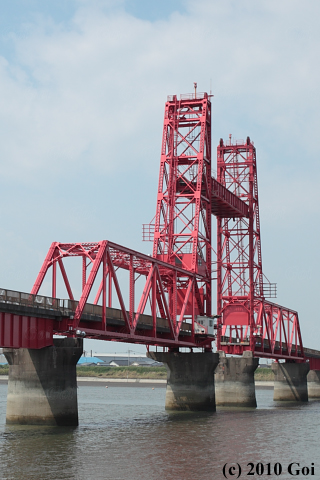
旧・筑後川橋梁は15径間からなり、昇開式の可動橋が1径間で架けられています。この可動橋では鋼製の下路式プレート・ガーダーが、その両側の径間の橋では鋼製の下路式直弦垂直材付きワーレン・トラスが、それらの基本構造のようです。他の12径間では、鋼製の上路式プレート・ガーダー橋が10径間で、鋼製の下路式プレート・ガーダー橋が2径間で架けられています。この上路式プレート・ガーダーのうち9径間では、端部の桁高が低いプレート・ガーダーが架けられています。
橋脚上端から塔の上端までの高さは、約30メートルあるようです。
Ex-Chikugogawa Bridge is composed of fifteen spans; one movable bridge of vertical-lift types has been spanned at one span. As for the movable bridge, plate girders which are made of steel of through types are seemingly basic construction; as for both of the side bridges, Warren truss with vertical posts which are made of steel with straight chords of through types are seemingly basic construction. At the other twelve spans; plate girder bridges which are made of steel of deck types, have been spanned at ten spans, and plate girder bridges which are made of steel of through types, have been spanned at two spans. At the nine spans in the plate girders of the deck types, plate girders of which the heights of ends are short were spanned.
It seems that the height from the top of the pier to the top of the tower is about thirty meters.
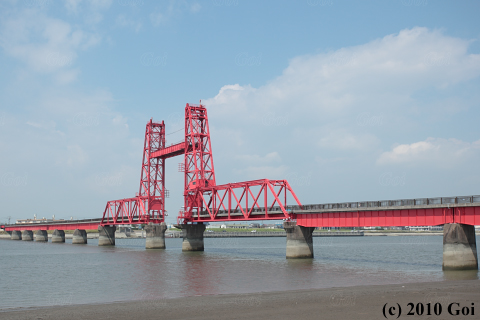
旧・筑後川橋梁の上部構造は横河橋梁により、機械装置は大阪安治鉄工により製作され、橋は昭和10年 (1935) 5月には日本国有鉄道 (国鉄) 佐賀線の鉄道橋として開通したようです。
国鉄佐賀線は既に廃止されていますが、旧・筑後川橋梁はその後に人道橋になり、現在は国により重要文化財に指定されています。
It seems that the superstructures of Ex-Chikugogawa Bridge were made by Yokogawa Bridge, and the machinery of that was made by Osaka Aji Tekkō (
?); the bridge was opened as a railway bridge of the Japanese National Railways (JNR) Saga Line in May, 1935.
The JNR Saga Line had been already abolished, but Ex-Chikugogawa Bridge afterwards became pedestrian bridges, at present, it has been designated as an Important Cultural Properties by nation.

